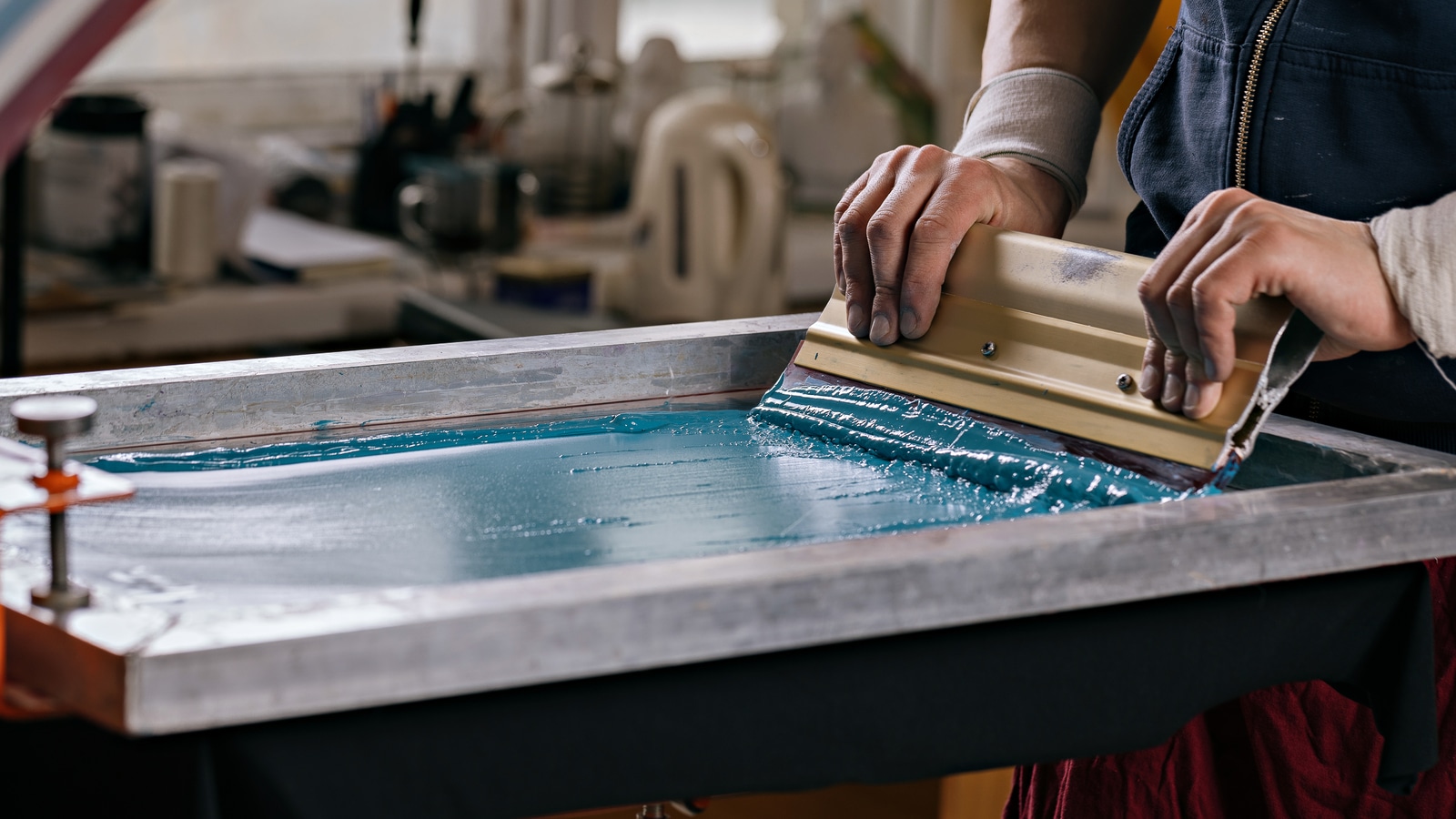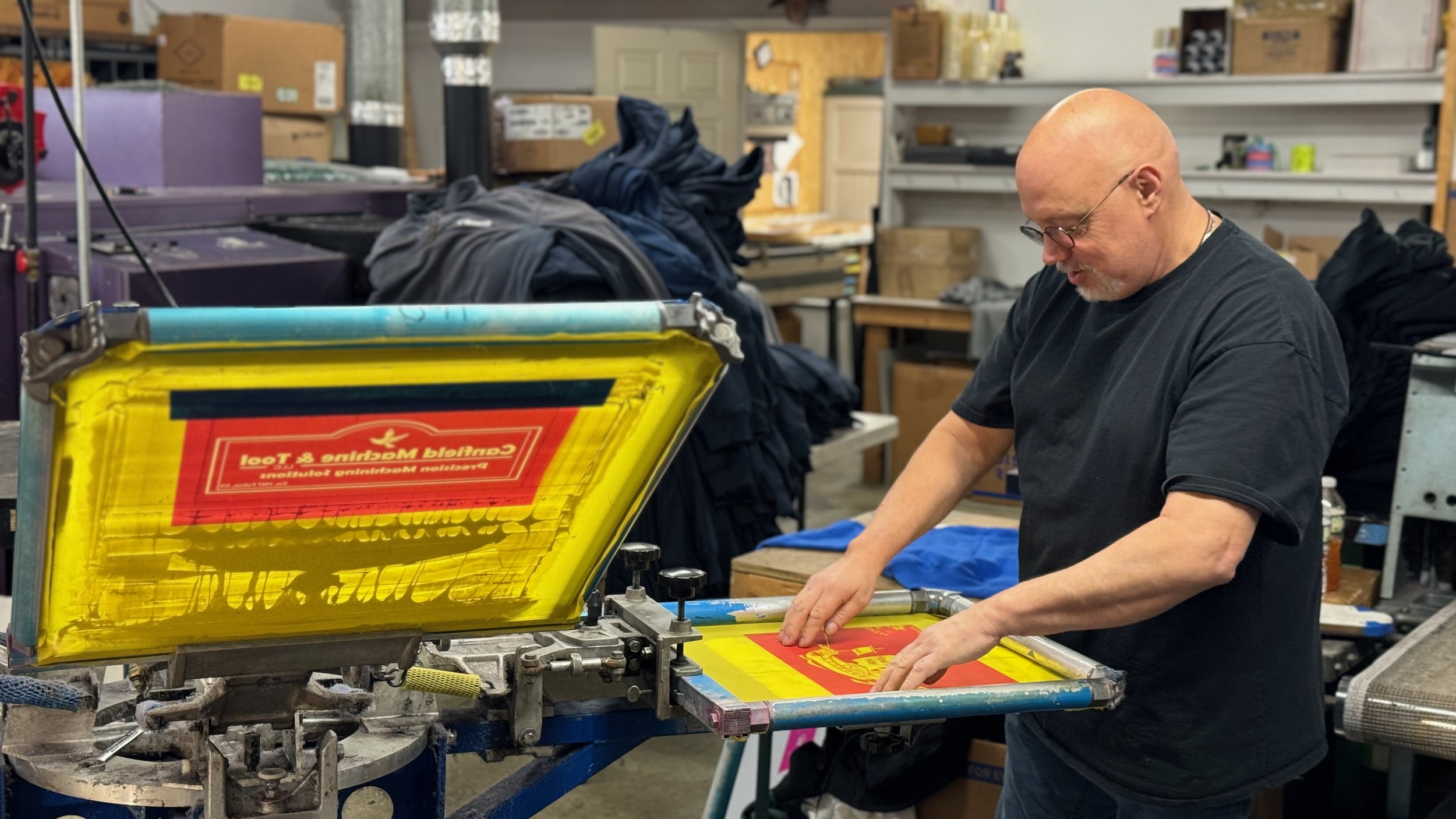Creative T-Shirt Printing Ideas for Small Brands
Creative T-Shirt Printing Ideas for Small Brands
Blog Article
Display Printing Uncovered: Whatever You Need to Know Regarding T-Shirt and Garment Printing Techniques
Display printing is a remarkable approach that integrates art with technique, using countless opportunities for imagination. All set to check out the vital aspects that make display publishing an art kind?
The Fundamentals of Display Printing: Just How It Works
When you plunge into display printing, you'll discover it's both a scientific research and an art. At its core, display printing includes creating a pattern, or display, that allows ink to go through just in details locations (screen printing kit). You begin by choosing your layout and preparing your display with a light-sensitive solution. Once you reveal this solution to light, it solidifies, leaving your layout as an unfavorable area.
Following, you'll mix your inks and prepare your printing surface area. Placement the display over the textile, then make use of a squeegee to press ink through the display onto the garment. This process needs precision, as you want clear, vivid prints. After printing, you'll treat the ink with warmth, ensuring it follows the material and lasts via laundries. Each action is crucial, and understanding them will raise your display printing skills, changing easy garments right into unique, expressive items.
Kinds Of Screen Printing Strategies
When you understand the essentials of display printing, it's time to discover the different methods that can raise your layouts. One preferred technique is standard display printing, where ink is pressed with a stenciled screen.
An additional option is plastisol printing, known for its toughness and vibrant colors, making it a preferred for lots of brands. Experiment with halftone printing to develop gradient effects and elaborate styles.
Important Equipment for Screen Printing
To accomplish spectacular lead to display printing, having the appropriate equipment is fundamental. Initially, you'll need a sturdy display printing structure, which holds the mesh that transfers your layout onto the garment. Next, spend in premium squeegees; these are crucial for applying ink evenly across the screen. You'll additionally need a great direct exposure device to develop your screens, as well as a washout booth for cleaning them after usage. A reputable heat resource, like a conveyor dryer or warm press, is critical for curing your prints to assure durability. Don't forget a proper work space, equipped with tables and storage space for your materials. Ultimately, safety equipment, such as gloves and masks, will keep you safe from chemicals and inks. With the right tools, you'll be well on your way to generating professional-quality prints.
Choosing the Right Inks and Products
When choosing inks and products for screen printing, you need to consider the type of ink that works ideal for your task. Think of fabric compatibility to assure your styles look great and last lengthy. Explore eco-friendly ink choices to make your printing procedure extra lasting.
Kinds Of Display Inks
Picking the appropriate screen ink is necessary for achieving vibrant, long lasting prints that meet your task's demands. There are numerous types of screen inks to examine. Specialized inks, such as metallic or glow-in-the-dark, can include one-of-a-kind impacts to your layouts.

Fabric Compatibility Considerations
Understanding fabric compatibility is important for accomplishing top notch display prints, particularly since various products react uniquely to numerous inks. Always evaluate your inks on example textile to ensure they adhere effectively and keep color stability. Furthermore, maintain in mind that textile weight and texture can affect the final end result, so choosing the appropriate ink and product combination is crucial for your project's success.
Eco-Friendly Ink Options
Green inks are becoming a prominent choice for screen printers who want to decrease their environmental influence while preserving quality. When selecting inks, take into consideration water-based inks, which are much less hazardous and easier to cleanse up contrasted to traditional solvents.
Furthermore, try to find inks made from renewable energies, such as soy or vegetable-based alternatives. By selecting the appropriate inks and materials, you'll not only develop stunning styles however also add to a more lasting printing procedure. Make the switch, and your prints will certainly mirror your dedication to the environment!
Preparing Your Layout for Display Printing

Submit Layout Needs
To ensure your layout looks vivid and sharp on material, you'll need to pay attention to file format demands for display printing. Start with vector data like AI or EPS, as they can be scaled without shedding high quality. If you use raster pictures, choose for high-resolution documents, such as TIFF or PNG, ideally at 300 DPI. Stay clear of using JPEGs, as they can lose clearness when resized. Additionally, make certain your layout has a transparent background to stop undesirable white edges on your prints. Ultimately, maintain shade modes in mind; CMYK is standard for screen printing, so transform your RGB makes appropriately. By following these guidelines, you'll set your artwork up for an effective print.
Shade Splitting Up Methods
Color splitting up is a crucial step in preparing your layout for display printing, and grasping it can significantly boost your print high quality. anchor You'll require to damage your design right into individual shades, as each shade needs a separate display during printing. This accuracy not only assures precise color depiction but likewise improves the printing process.
Resolution and Dimension
Attaining the finest outcomes in screen printing begins with ensuring your layout has the best resolution and dimension. Preferably, your art work ought to go to least 300 DPI (dots per inch) for sharp, clear prints. If you make use of reduced resolution, your final item could look pixelated and less than professional.
When it concerns dimension, consider the dimensions of your print location. Layout your art work to match the home final print dimension, ideally creating it in the real dimensions you'll be publishing. By doing this, you'll stay clear of any unanticipated scaling problems.
Constantly check your style in both vector and raster layouts. Vector graphics can be scaled without shedding high quality, making them perfect for screen printing. Preparing properly will assure your layout looks impressive on every garment!
Step-by-Step Screen Printing Process
Screen printing is a dynamic process that allows you to develop vivid designs on numerous surfaces. To get begun, you'll need a display, solution, and your chosen ink.
Put ink onto the display and use a squeegee to push the ink through the pattern onto the fabric. Raise the screen very carefully and let the print completely dry. You've efficiently display printed your layout.
Tips for Effective Display Printing Projects
While you're diving into your screen printing projects, keep in mind that prep work is essential to success. Beginning by collecting all your materials-- inks, garments, displays, and squeegees. A tidy work area aids avoid unwanted mistakes, so clean prior to you begin.
Next, confirm your artwork is high-resolution and effectively sized for your garment. Test your display for proper exposure and tidy it completely to stay clear of smudges. When blending your inks, follow the supplier's guidelines to accomplish the appropriate uniformity.
Throughout printing, use even stress with your squeegee for regular results. Do not hurry; take your time to verify each print try these out satisfies your standards. After printing, allow your garments dry entirely before managing or packaging them.
Last but not least, always maintain a sample of your help future recommendation. By doing this, you can assess your development and boost your strategies over time. Delighted printing!

Regularly Asked Inquiries
The length of time Does It Require To Establish up a Display Printing Task?
Establishing a display printing task normally takes about thirty minutes to an hour. You'll prepare the screens, mix inks, and adjust journalism. The moment differs based on intricacy and experience, so stay organized!
Can I Publish on Various Material Enters Making Use Of the Very Same Method?
Yes, you can print on different textile kinds making use of the very same strategy, however you'll require to change your inks and settings. Some materials absorb ink in a different way, so experimenting guarantees the most effective results for each and every product.
What Are Typical Mistakes to Stay Clear Of in Display Printing?
When display printing, prevent common blunders like utilizing the wrong ink, overlooking proper exposure times, or avoiding pre-press checks. Constantly evaluate your arrangement and maintain tidy screens to guarantee high quality outcomes each time.
Just How Can I Correctly Tidy and Preserve My Display Printing Equipment?
To effectively tidy and keep your screen printing tools, you should on a regular basis wash displays with suitable solvents, inspect mops for wear, and ensure all devices are saved dry and dust-free. Uniformity enhances and stops costly repair services efficiency.
Is Screen Printing Eco-friendly Compared to Other Approaches?
Screen printing can be much more eco-friendly than other methods, specifically if you use water-based inks and eco-conscious products. By picking sustainable products and methods, you reduce waste and reduce your influence on the earth.
Display Printing Uncovered: Everything You Need to Know Regarding Tee Shirt and Garment Printing Strategies
At its core, display printing involves creating a stencil, or screen, that enables ink to pass with just in specific areas. Setting the screen over the material, after that make use of a squeegee to push ink via the display onto the garment. One preferred approach is typical display printing, where ink is pressed with a stenciled screen.When selecting inks and materials for display printing, you require to take into account the type of ink that works finest for your project.
Report this page